|
Improving environmental relations, tourism and trade depends on putting into service a road network with sufficient capacity. The importance of road network and transportation policy which is an element to provide common interests and ties among the nations increases day by day.
In order to reach the targets and realize the plans which are specified within the restructuring period, infrastructure; such as, transportation, communication and energy sectors, should be in a sufficient condition to fulfil its duties , then desired results will be achieved. Furthermore, the common interests of nations are as follows; for instance, the purpose of developed countries to improve the trade, the desire of East Europe, Black Sea, Caucasus and Middle East countries to transfer technology and to integrate with developed countries. Thus those interests require to be organized around the road networks to be constructed. To this end, new initiatives have started and new organizations have been formed.
Turkey is a bridge between continents, suitable for multi-mode transportation. Furthermore, opening of new border gates towards Caucasus and the countries around Caspian Sea, establishment of new links within the framework of international projects are being planned. All these factors increase its importance and require its participation in the works actively.
Trans Turkey Highway (TTH)
TTH route of 3 200 km., which has vital importance in Turkey's main road system, starts at Bulgarian border. It passes through İstanbul,Gerede and Ankara, then it parted into two, one of its branches ends at Syrian border, the other ends at Iraqi border. Another branch starts in Gerede, passes through Refahiye, Erzincan and ends at Iranian border. TTH is connected to road network of Europe and Central Asia. It is the shortest transit route between Central Asia, Western Asia and Northern Africa.
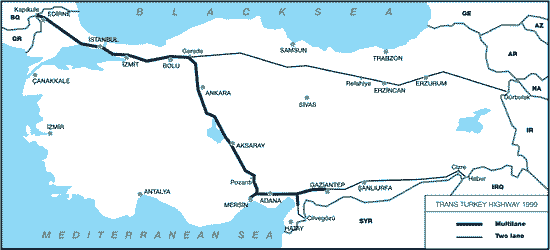
Traffic density in TTH route varies between 40-50% however this rate increases to 60% at border crossing points. The rate of foreign vehicles at border crossing points is 40-50% while it is 2-3% in metropolitan cities.
Continuously increasing domestic and international traffic in TTH route is thought that the deformation of pavement rapidly and the insufficiency of capacity in TTH network. Hence General Directorate of Highways has started to improve the roads within the framework of a program beginning with the sections of TTH which have priority.
The improvement program aforementioned doesn’t require the construction of new roads. The main purpose of the program is to enhance the physical standards of the road in order to make it sufficient for the traffic. During the works slight geometric improvements and especially some safety measures are taken into consideration.
Trans European South-North Motorway Project (TEM)
The Project of Trans European South-North Motorway, namely TEM, is a regional transportation infrastructure project. It starts from Poland and reaches Asia via Turkey and also covers Middle East, Southeast European countries. Within the scope of this project, the full members are Austria, Bosnia-Herzegovina, Bulgaria, Croatia, Czech Republic, Georgia, Hungary, Italy, Lithuania, Poland, Romania, Slovakia and Turkey. Sweden and Ukraine has the observer members status.
TEM road network in Turkey starts at Bulgarian border , passes through Istanbul via Fatih Sultan Mehmet Bridge and parted into two branches in Ankara as eastward and southward. Eastern branch is again parted into two branches in Aşkale. One of them reaches Trabzon in Black Sea Region, the other ends in Gürbulak at Iranian border. The southern branch ends at Syrian and Iraqi border. Furthermore, it connects İstanbul to İzmir and Antalya. The total length of TEM in Turkey is approximately 6 954 km. by January 2001.
Economic Cooperation Organization (ECO)
ECO is a cooperation organization established by Turkey, Iran and Pakistan. By the time the number of its members increased to ten. As ECO routes provide integration between member countries they also give service to international traffic. Therefore, its service level should be raised in order to provide harmonization with common international standards.
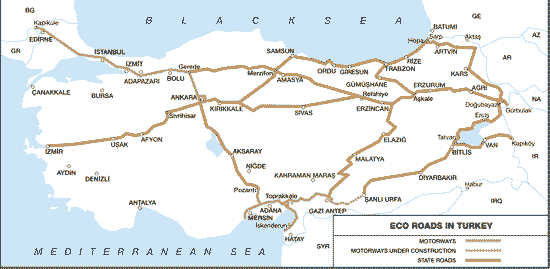
ECO routes in Turkey give service as the first class state highway with asphalt pavement. In some sections the works related to raising the standards go on within the framework of Investment Program.
ECO routes in our country are the shortest one connecting ECO countries to developed European countries and Middle East ones.
Black Sea Economic Cooperation (BSEC)
“The Declaration Of Black Sea Economic Cooperation Summit” was signed by Turkey, Greece, Bulgaria, Romania, Albania, Armenia, Georgia, Moldavia and Ukraine on June 25, 1992 in Istanbul. The main target of the cooperation is to establish the required grounds for a transportation network in region and for its development.
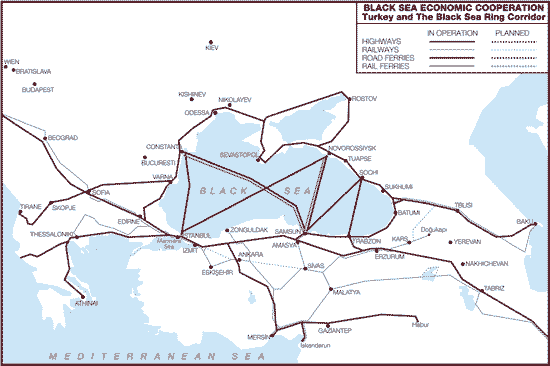
Black Sea Ring Corridor in Turkey promote a new link between East and West. Because of this, two-lane highway standard will be converted into multi-lane one. This corridor will connect our artery network to Black Sea countries, Caucasus, and via Caspian Sea by ferry-boat service to Central Asia and Far East. It has been planned that Black Sea Ring Corridor should be completed in parts and opened to service before the year of 2002. The aforementioned route will connect BSEC countries to Europe.
In 21st century, the region has an increasing importance within both global policy and economy. Therefore, “BSEC Organization Condition” was prepared in Yalta Summit on June 5, 1998 in order to convert the cooperation into a regional economical organization and submitted for signature. To convert BSEC into an organization and create an action plan as soon as possible will be useful for a highway network construction to integrate the different regions and provide transportation around Black Sea.
International E-Roads
After the Second World War “The Declaration For The Construction Of International Arteries” (AGR) was prepared by United Nations Economic Commission for Europe UN/ECE on September 16, 1950 in Geneva.
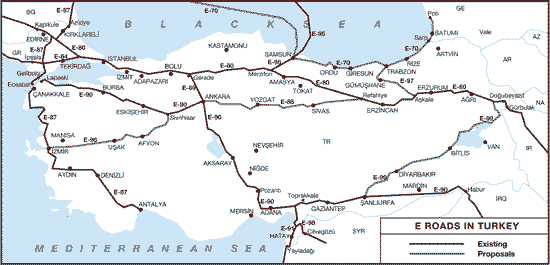
Turkey is an extension of International Road Network of Southern Europe (AGR). According to the provisions of AGR two arteries reach Turkey. These are E-80 entering from Bulgarian border (Kapıkule) and E-90 entering from Greek border (Ipsala). These two main routes reach International Road Network of Middle East and Asia at southern and eastern borders of Turkey via Anatolia.
UN/ECE spends great effort to extend E-Roads to Caucasian and Middle East countries. The map below includes the latest suggestions about E-Roads in Turkey.
Economic And Social Commission For Asia And Pacific (ESCAP)
ESCAP was first founded with the name of UN Economic Commission For Asia And Far East by UN Economic And Social Commission in 1974. Its secretariat is in Bangkok. Its studies cover the region from Iran to Cook Islands in Pacific.
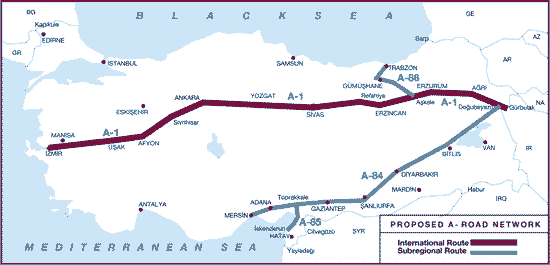
Turkey’s membership to ESCAP started legally on July, 1996.
The meeting titled “Road Transportation Corridor Between Central Asia And Europe” was held on the political level on June 17-20, 1997 in Bangkok. During the meeting recommendations and results were specified about to the three corridors determined.
The corridors are as follows:
•Northern Corridor; connects Central Asia to Europe via Russian Federation and Ukraine/ Belarus.
•Central Corridor; connects Central Asia to Europe via Caspian Sea, Caucasian countries (Azerbaijan, Armenia, Georgia) and Black Sea, Russian Federation, Ukraine/Turkey.
•Southern Corridor; connects Central Asia to Europe via Iran and Turkey.
It was suggested that a detailed study had to be carried out on the corridor and routes between Central Asia and Europe as a continuation of the studies. Then it was stated that the connections with Pan-European Corridors had to be taken into consideration during the studies.
The studies related to determining A-Roads (Asian Highway Network) within the boundaries of Turkey started with the cooperation of ESCAP experts who visited our country in February 1998 and March 1998. These studies have still continued. Within the framework of this studies ESCAP experts prepared a Draft Country Report of Turkey. Our view and recommendations concerning the Report and additional information have been submitted to ESCAP Secretariat.
It was demanded that member countries should be a party in the conventions stated in the provision with the number of 48/11 in ESCAP documents as soon as possible. Turkey is not a party in Highway Traffic Convention (1968) and Highway Signs and Marking Convention (1968) yet. However, General Directorate of Highways spends effort to be a party in the conventions aforementioned.
Pan-European Corridors
After European Union (EU) commission was assigned with the coordination of assistance to Central and East European Countries (CEEC), G-24 working group emerged as a result of the formation of working groups of sectors. Transportation Working Group met in June 1991 for the first time. CEEC actively participates in its works. Group decided to carry on its works with a regional point of view especially with a Pan-European one. Also it organized many conferences until now.
The process to fix the corridors and projects having priority started in November 1993 with the purpose of speeding the works up. As a result of II. Pan-European Conference in Crete on March 14-16, 1994, nine corridors, which had priority and had been the subject for the studies, were determined.
These corridors are as follows:
I. Corridor : Talin- Riga- Warsaw
II. Corridor : Berlin- Warsaw- Minsk- Moscow
III. Corridor : Berlin/Dresten- Wroclaw- Lvov- Kiev
IV. Corridor : Berlin/Nuremberg- Prague- Budapest- Constantsa/Salonica/İstanbul
V. Corridor : Trieste-Ljubijana-Budapest-Bratislava-Uzgorod-Lvov
VI. Corridor : Gdansk-Warsaw-Zilina
VII. Corridor : Danube
VIII. Corridor : Durres-Tirana-Uskup-Sofia-Varna
IX. Corridor : Helsinki-Kiev/Moscow-Odessa/Kishinev/Bucharest-Filibe
Within the framework of preparations for Pan European III. Transportation Conference which was held in Helsinki in June 1997, G-24 Transportation Working Group Meeting had been held in Brussels on July 1-3, 1996. During the meeting improvements and adaptations related to corridors having priority which take place in Pan European transportation network were dealt with.
Participants demanded that new corridors and current ones had to be extended in the meeting to which representatives from Turkey also attended. Turkish representatives submitted motion prepared through the advice of the Ministry of Transportation and the Ministry of Foreign Affairs. In this motion it has been suggested that IV. Corridor should not be ended in İstanbul but should extend east and southeast parts of Turkey.
III. Pan European Transportation Conference was held in Helsinki on June 23-25, 1997. In aforementioned conference X. Corridor (Budapest-Belgrad-Uskup-Salonica-Athens and Titov-Veles-Prilep-Bitola-Greece) was officially accepted which extends towards Athens covering Yugoslavia as the conflicts in this region ended up . It was emphasized that adding X. Corridor to current 9 ones would be sufficient and there was no need for changes except for the insufficient lines between 10 Corridors. Furthermore, it was suggested that Pan European Transportation corridors should be categorized under 4 region as Barent Euro- Arctic Area, Black Sea Area, Mediterranean Basin Area, Adriatic/ Ion Seas Area, in order to execute the works and studies in a much more functional way.
The works related to the corridors has been executed within the framework of these fixed areas.
Aforementioned corridors are the extension of Trans European Networks in CEEC. Trans European Transportation, Energy and Environment subcommittee is one of eight committees formed for the analytical inspection of acquis communautaire of European Union. The significance of Pan European transportation corridor has increased concerning to the latest developments between EU and Turkey.
| 
